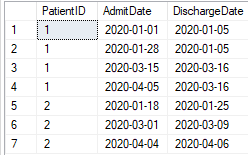Hi All,
I need to return query results of a table with one of the column values updated to that of another row's column value some of the time. What I can't seem to do with LAG or LEAD is use that updated value to determine if a third row's column value should be updated, which is why I think a recursive CTE sounds appropriate.
We have a list of patients hospital stays, with some patients having multiple rows. If a patient's second hospital stay started less than 30 days after their first hospital stay, we want the discharge date of the second hospital stay updated to use the discharge date of the first hospital stay. We want to continue this compare-and-update process for every row (other than the first row) for all of the remaining records for that patient. For example, here's my table:
CREATE TABLE #PatientStays ( PatientID INT , AdmitDate DATE , DischargeDate DATE);
INSERT INTO #PatientStays VALUES
(1, '2020-01-01', '2020-01-05') ,
(1, '2020-01-28', '2020-02-02') ,
(1, '2020-03-15', '2020-03-16') ,
(1, '2020-04-05', '2020-04-11') ,
(2, '2020-01-18', '2020-01-25') ,
(2, '2020-03-01', '2020-03-09') ,
(2, '2020-04-04', '2020-04-06');
And here's how we want the results returned:
SELECT 1 AS PatientID, '2020-01-01' AS AdmitDate, '2020-01-05' AS DischargeDate
UNION ALL SELECT 1, '2020-01-28', '2020-01-05' UNION ALL
SELECT 1, '2020-03-15', '2020-03-16' UNION ALL
SELECT 1, '2020-04-05', '2020-03-16' UNION ALL
SELECT 2, '2020-01-18', '2020-01-25' UNION ALL
SELECT 2, '2020-03-01', '2020-03-09' UNION ALL
SELECT 2, '2020-04-04', '2020-03-09'
Thanks for any help you can provide. I've done some reading on recursive CTE's, but everything I find seems to be more complicated than what I'm trying to do and I get tangled up.
Thanks again,
Eric

